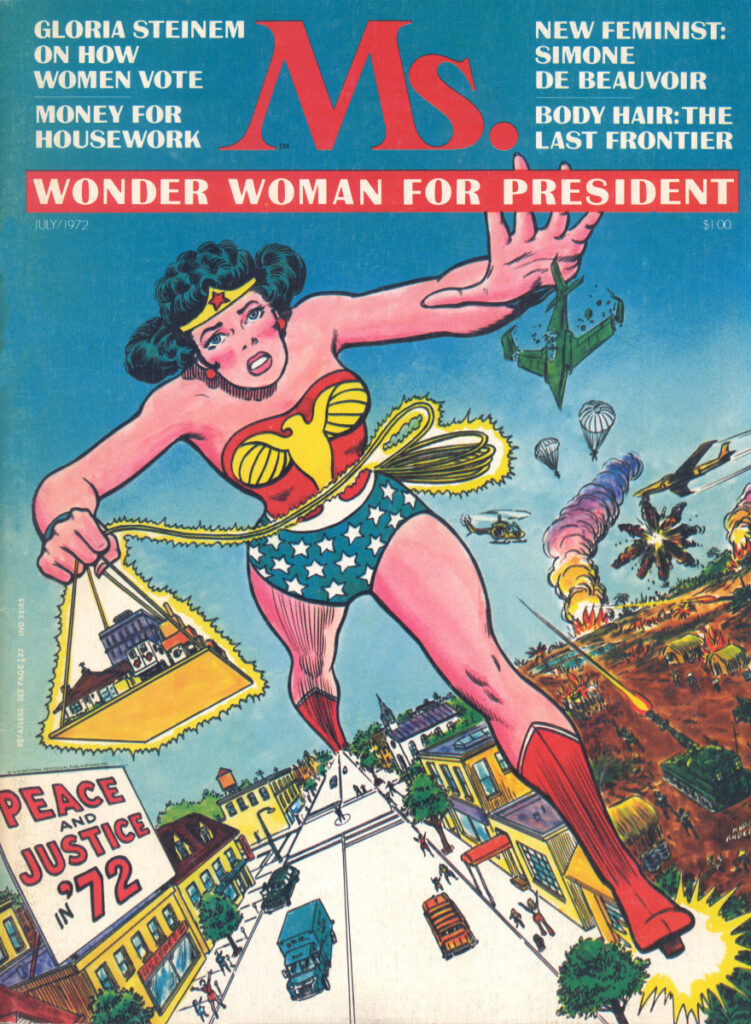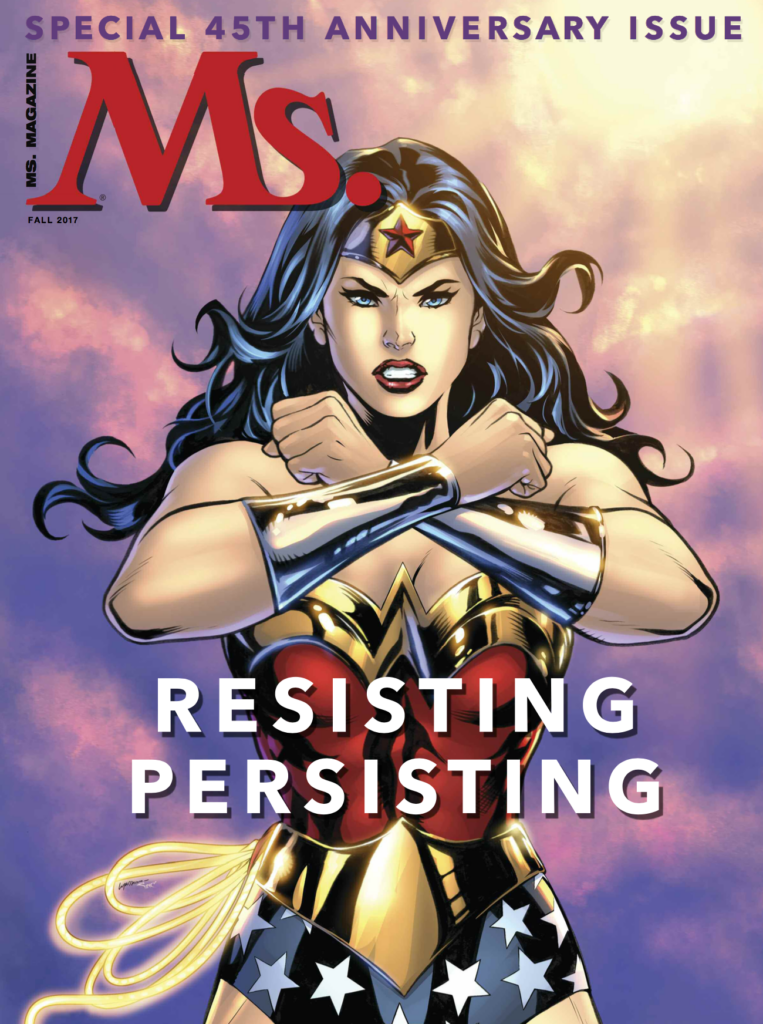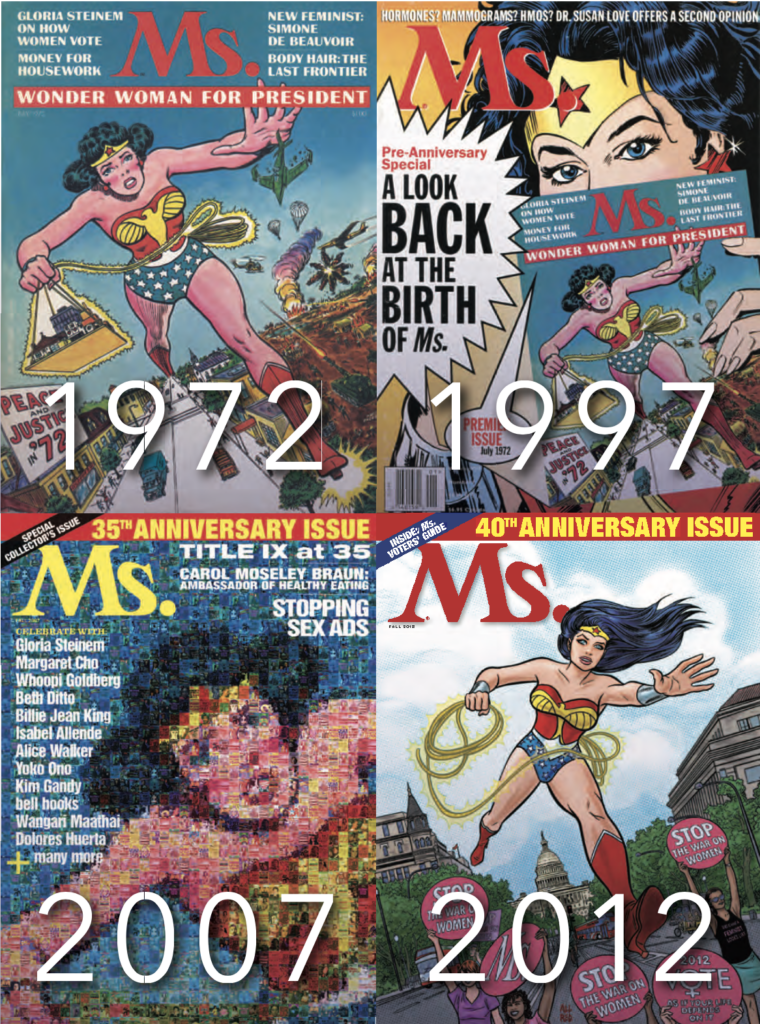
Season six of the Smithsonian’s podcast “Sidedoor” started with a bang—or perhaps a lasso strike. Hosted by Lizzie Peabody, and featuring Joanne Edgar and Suzanne Braun Levine, both former editors of Ms., the first episode explores the history of Wonder Woman.
Together, they trace how Wonder Woman evolved from a superhero to a feminist symbol. The first issue of Ms. magazine, with Wonder Woman gracing the cover, was a groundbreaking moment in feminist history. And it was also a turning point for Wonder Woman. As Peabody explains, Ms. needed Wonder Woman, but Wonder Woman also needed Ms.: The first issue cover “plucked a superhero wallowing in midlife crisis and transformed her forever from comic book hero to icon,” said Peabody.
Listen to the episode here:
Wonder Woman is not new. She has an enduring, if mottled, 76-year legacy as a comic book hero, feminist icon, television idol, action figure, animated character and, now, more than $800 million box office draw. Ms. magazine aligned itself with the Amazonian fighter for peace and justice from its inception, featuring the red-, white- and blue-bedecked heroine on the cover of its first full issue.
Five times, to date, Wonder Woman has graced this magazine’s cover, linking her inexorably with women’s empowerment and feminism writ large.

Like feminism, Wonder Woman is not without her controversies or detractors. Created in 1941 by psychologist William Moulton Marston, Wonder Woman marked the first entry of a significant female superhero onto the comic book scene. Comics were an influential entertainment market, especially for children and teenagers, and the Amazon hero’s appearance just as America officially entered World War II meant she could serve as constructive propaganda, espousing American values and urging women and men to do their part in the war effort.
In this original version of Diana’s story, the goddess Athena herself implores the queen of the Amazons to allow her daughter to accompany Steve Trevor, a pilot Diana rescues from the shore of her island after his plane crashes during pursuit by a Nazi fighter.
“American liberty and freedom must be preserved!” Athena maintains. “You must send with him your strongest and wisest Amazon—the finest of your wonder women!—for America, the last citadel of democracy, and of equal rights for women, needs your help!”
America of the 1940s was certainly no haven of equal rights for women, but Marston fervently believed in the necessity of “femininity” to help counter the “blood-curdling masculinity” of other popular superheroes, who always relied on violence and force to save the day. Reflecting on his decision to create Wonder Woman a few years after the character proved her popularity, Marston explains how “not even girls want to be girls so long as our feminine archetype lacks force, strength, power.” It’s disappointing, but perhaps not surprising, that Marston still championed “feminine tenderness and allure” for his superheroine, in addition to her more practical powers: super strength, altruism and love.
While we may find Marston’s staunchly anti-war attitude and belief that the greater empowerment of women would achieve a more peaceful and happy society laudable, his insistence upon Wonder Woman’s tender femininity is not as appealing. Nor is his seeming obsession with depicting his hero in frequent situations of sexualized vulnerability (sometimes even bound by her own magic lasso!) or his conceit that Diana’s main reason for leaving her island home is her instantaneous love for Steve, the first man she’s ever met.
Thankfully, the 2017 film emphasized Diana’s love for humanity, peace and justice as her primary motivations for venturing from Themyscira’s shores. Although Steve does become a romantic interest eventually, he is not Diana’s primary focus. During one heated exchange, she even tells him pointedly, “What I do is not up to you.”
The distinction between love and romance—and, in a related sense, the degree to which the character caters to men—has been a sticking point of Wonder Woman’s feminist credentials since the beginning. In the cover article of the first issue of Ms. magazine, co-founding editor Joanne Edgar discusses how her childhood love of the comic faced disenchantment when romance featured more heavily in later narratives. Edgar saw early Wonder Woman as a character who “captured the Amazonian spirit of strength and self-sufficiency, but added the peacefulness and revulsion toward killing that have culturally distinguished women from men.”
There was no question that Wonder Woman was worth rehabilitating, via the cover of Ms. and in the comic itself, which saw a shift in story lines due at least in part to the interventions of Gloria Steinem and other advocates of women’s rights. Edgar recalls how Ms. editors wanted an iconic, feminist symbol for their first issue, not a real woman who would then bear the brunt of everyone’s heightened expectations. The comic book hero fit the bill nicely: She was anti-war, believed in sisterhood and fought for those less fortunate.

For better or worse and real or not, Wonder Woman has not escaped the burden of representation faced by other “firsts” or “onlys” at her level. As a character, she is often expected to speak for and to all women, an impossible task. In her long history, Wonder Woman has served as a lightning rod on issues around race, class, sexuality and gender. She’s been accused of being a corporatized symbol of white liberal feminism; she’s faced dueling allegations of inspiring girls to pursue lesbianism versus too often falling victim to heterosexual romance plotlines for someone from an all-female island; she’s withstood arguments over whether her minimal outfit catered to the male gaze or merely emphasized her freedom from patriarchal fashion constraints; and, despite her anti-war bona fides and her preference for defensive fighting over gratuitous bloodshed, she’s been criticized as overly violent.
Many of the criticisms lobbied at Wonder Woman in her various incarnations have validity, but it’s a testament to her symbolic significance that she’s endured nonetheless. Epitomizing women’s potential, the possibilities of feminism and the hopes of humanity, Wonder Woman “has still managed to reach icon status, which isn’t accidental,” writes Angelica Jade Bastién in Vulture. “It’s indicative of the hunger for female-oriented stories, especially coming-of-age tales, that go against the usual depictions of female strength.”
Wonder Woman stands tall as a symbol for women and for feminism whether we’re convinced of her credentials or not. As the recent films emphasize frequently, believing in yourself is the first step toward changing the world. During Diana’s initial training, the Amazon general Antiope (Robin Wright) tells her young charge, “You are stronger than you believe. You have greater powers than you know.”
In one of the film’s most tremendous scenes, Diana ignores Steve’s warning that No Man’s Land can’t be crossed. “We can’t save everyone in this war,” Steve admonishes. “This is not what we came here to do.” In response, Diana sheds her cloak to reveal her full armor and climbs out of the trench to face the German soldiers on the other side head-on, responding, “No, but it’s what I’m going to do.”
On its cover, the July 1972 issue of Ms. declares “Wonder Woman for President!” Looking back on this inspiring slogan decades later, it emphasizes how far we’ve come—with Vice President Kamala Harris recently breaking the glass ceiling in the executive branch—and how far we still need to go to fight for our feminist ideals.
Editor’s Note: Part of this piece is excerpted from “Peace Strength Wisdom Wonder” by Aviva Dove-Viebahn, originally published in the Fall 2017 print issue of Ms.
You may also like:




